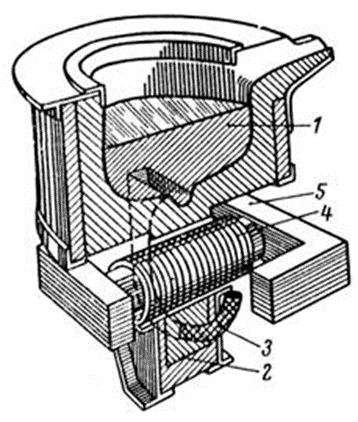Energy saving in induction furnaces
Induction furnaces are widely used in the heavy industry of Ukraine. Therefore, the issue of rational energy management of their use is very important for energy saving in metallurgy, mining and other sectors of the economic complex of the country.
The operation of induction furnaces (induction heating installations) is based on the release of heat during the interaction of an alternating electromagnetic field with materials (metals, graphite, etc.) that conduct electricity. The alternating electromagnetic wave, penetrating the body of the conductor, induces Foucault currents in it, which cause heating in the body. Due to the fact that the heat sources are inside the body, the heating can be carried out in a minimum time, selecting the appropriate frequency of the electromagnetic wave. At high enough frequencies, the heat sources will concentrate on the surface and the heating will be "surfaced". Conversely, at a relatively low frequency of the electromagnetic field, the conductor will be heated to its full depth. Such heating is called "constant".
Measures to save electricity in induction furnaces.
- Proper operation of the furnace, maintenance of lining and electrical equipment in working condition, compliance with the schedule of planned and preventive works;
- Support of high values of power factor;
- Maintaining the optimal level of "swamp" when draining metal;
- Organization of round-the-clock operation of furnaces instead of one- or two-shift operation of furnaces;
- Reduction to the minimum required values of the idle time of the furnace;
- Replacement of inefficient, morally and physically worn out furnaces with modern furnaces with higher efficiency.
Induction melting furnaces are widely used in industries, especially in metallurgy. By design, they are divided into channel and crucible.

Fig. 1. Duct furnace
1 - molten metal; 2 - lining; 3 - channel; 4 - inductor; 5 - magnetic circuit.
Duct furnaces are similar in design and substitution scheme to a power transformer, in which the inductor is the primary winding, and the secondary winding is one turn of molten metal 1, located in the channel 3 of refractory material 2. As in the transformer, it is made of transformer steel 5 magnetic circuit. The lining 2 protects the inductor 4 from molten metal. The inductor is made of copper (more often from pipes), it has intensive forced cooling. The metal is heated in the channel and under the action of electromagnetic forces is ejected into the bath 1, with the molten metal. An industrial frequency is used to power duct furnaces.

Fig. 2. Crucible induction furnace
Crucible furnaces consist of an inductor, which covers the crucible made of refractory material. Transformer steel packages are installed around the inductor to reduce energy losses due to magnetic flux scattering. An alternating voltage of industrial, medium or high frequency is supplied to the inductor. The alternating electromagnetic wave enters the metal in the crucible, heats, melts and brings the metal to the desired temperature.
In medium frequency furnaces, the metal usually merges completely. The performance of the furnace significantly depends on the stacking of the charge in the crucible.
A necessary condition for the economic operation of the crucible furnace of industrial frequency is the incomplete discharge of metal, leaving the "swamp" - not less than 25 ÷ 30% of liquid metal. This is due to the fact that with incomplete draining of the metal at the same voltage, the power consumed by the furnace will be higher than at the initial stage of melting of only a small charge. And the most rational mode of operation of such furnaces is the mode with frequent selections of metal in small portions - 20 ÷ 30% of the crucible capacity. At the same time after each drain it is necessary to add the corresponding portion of charge.
